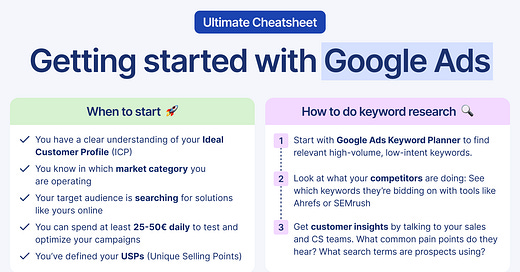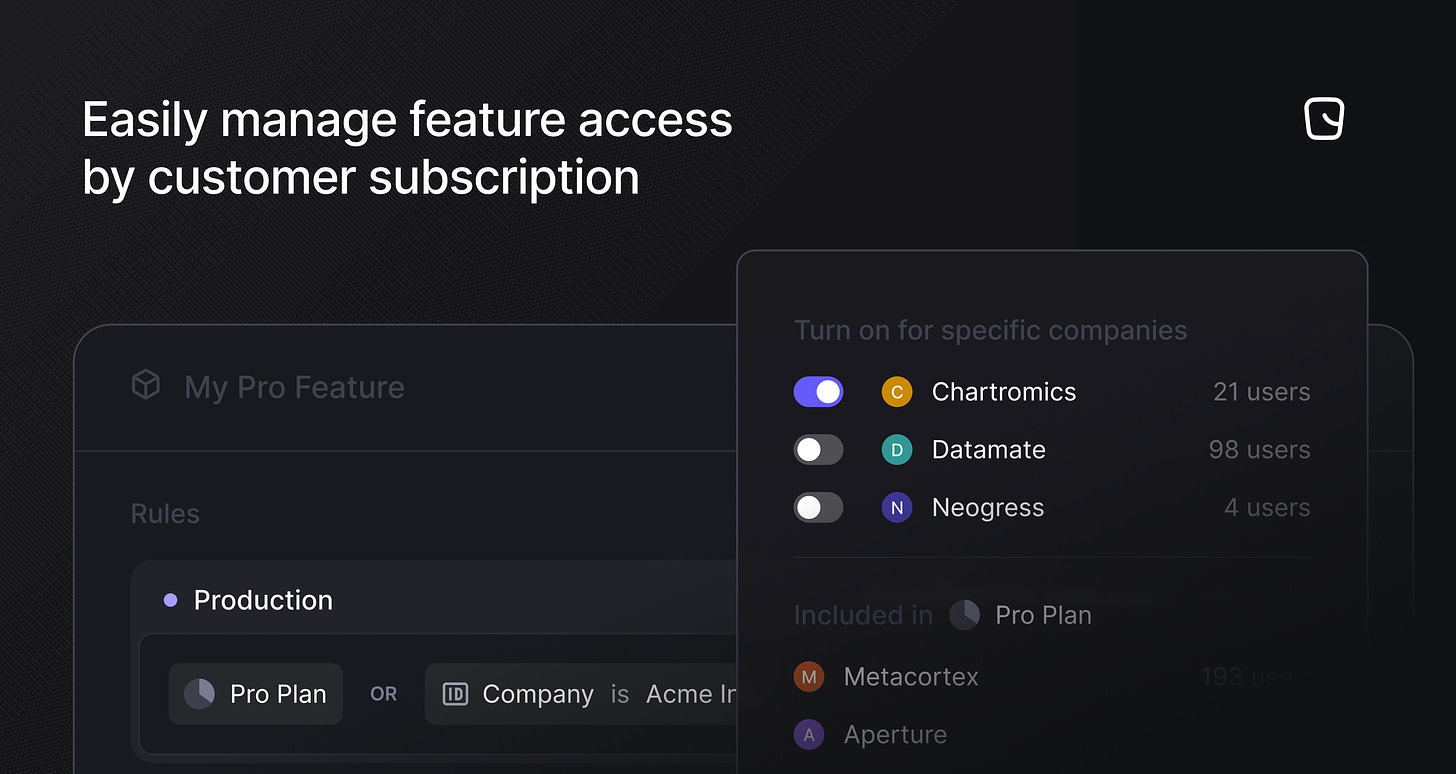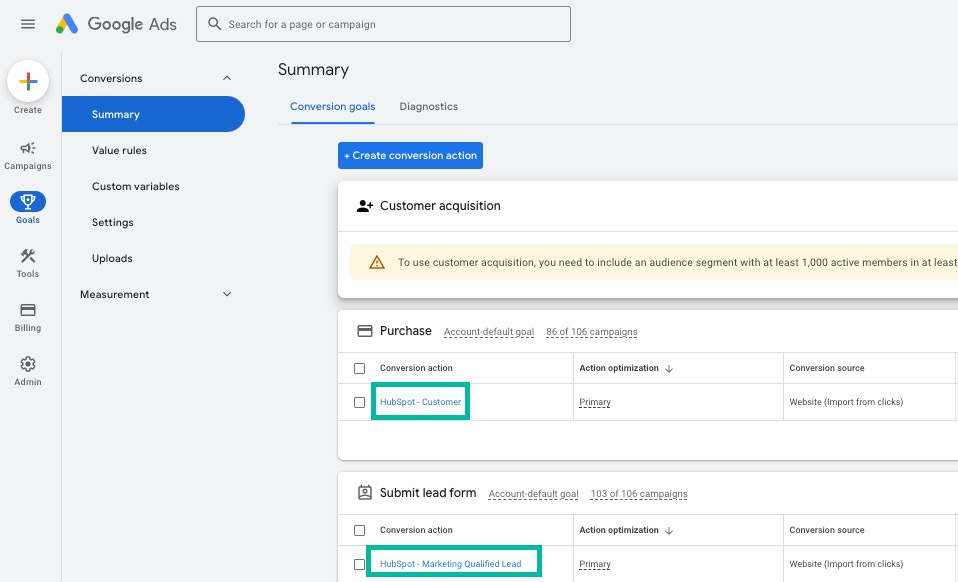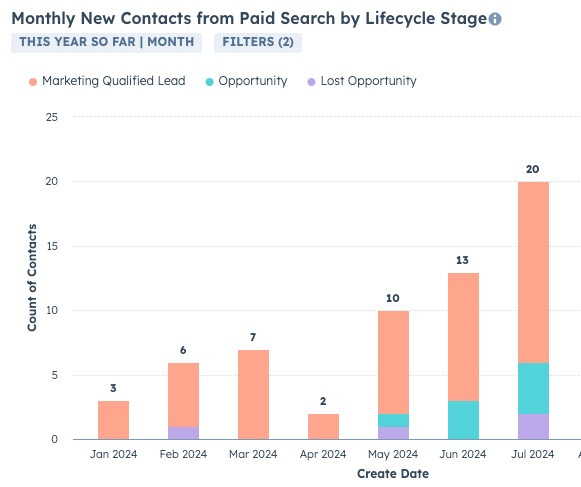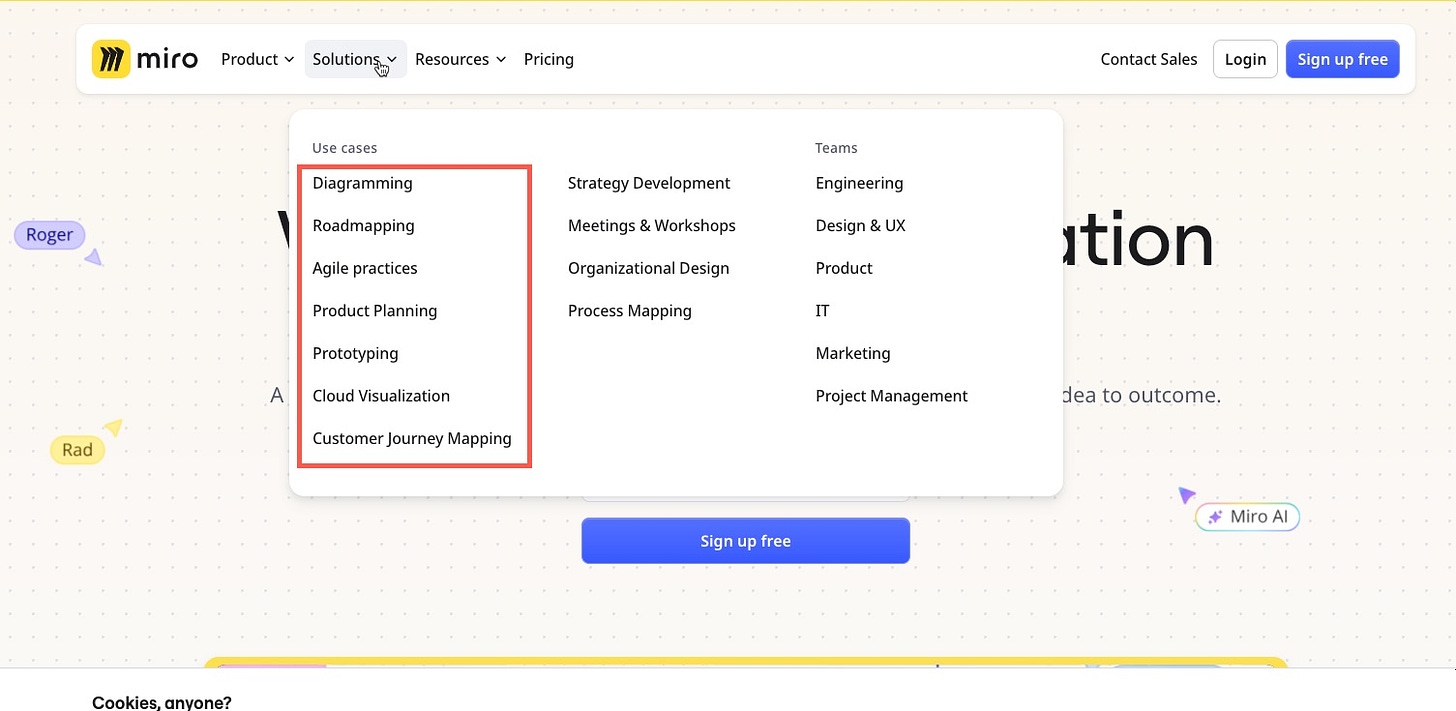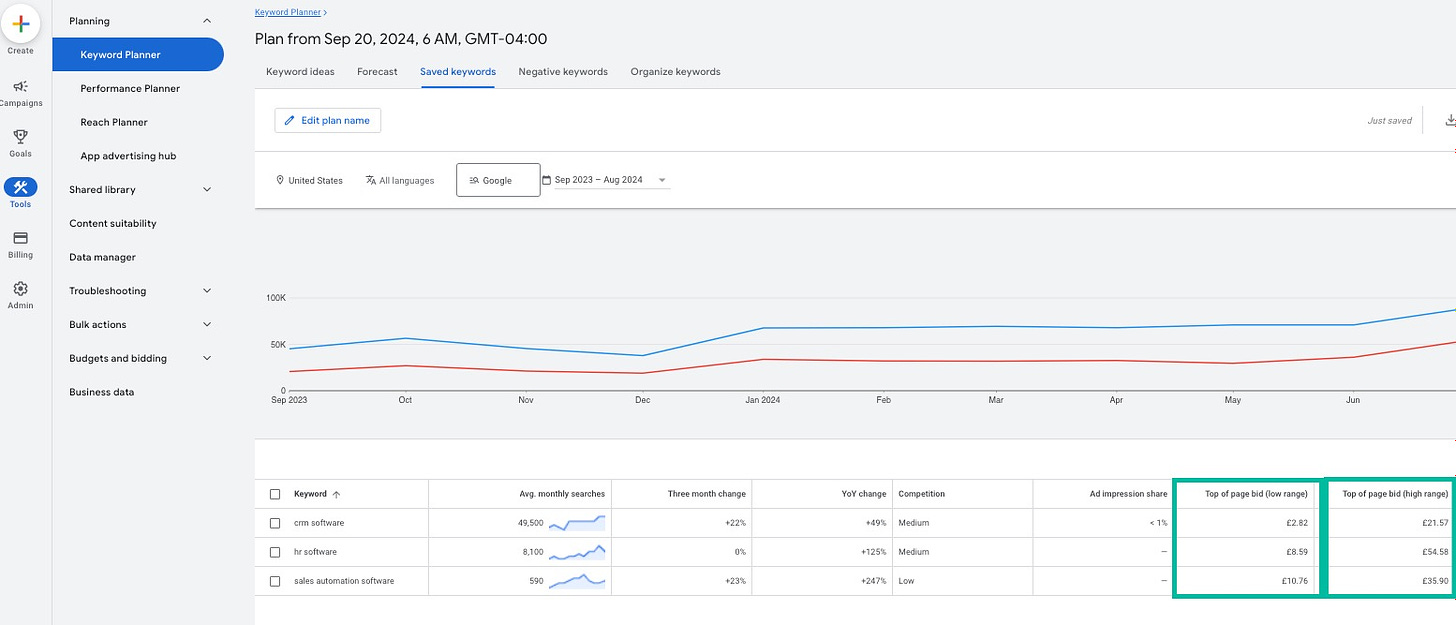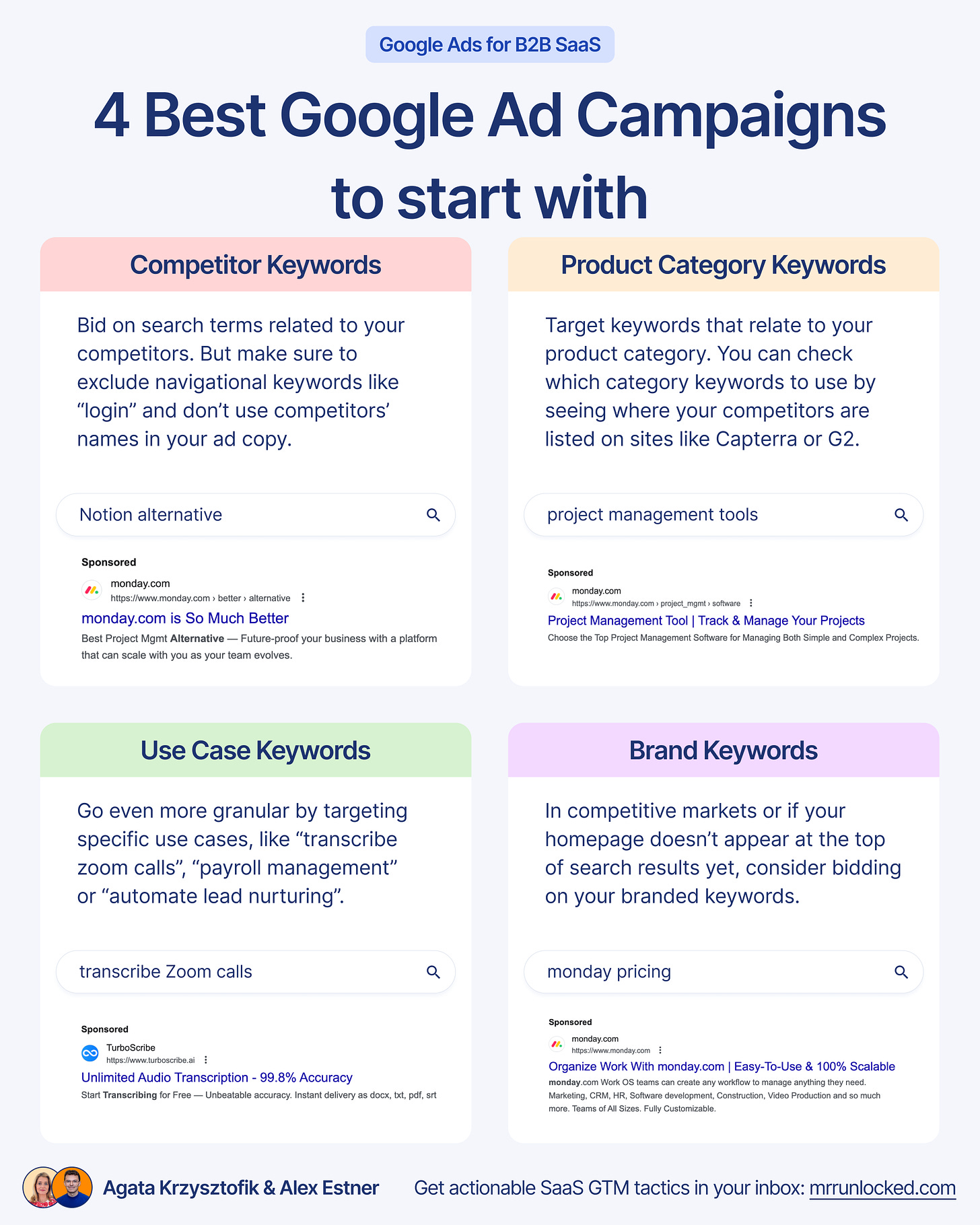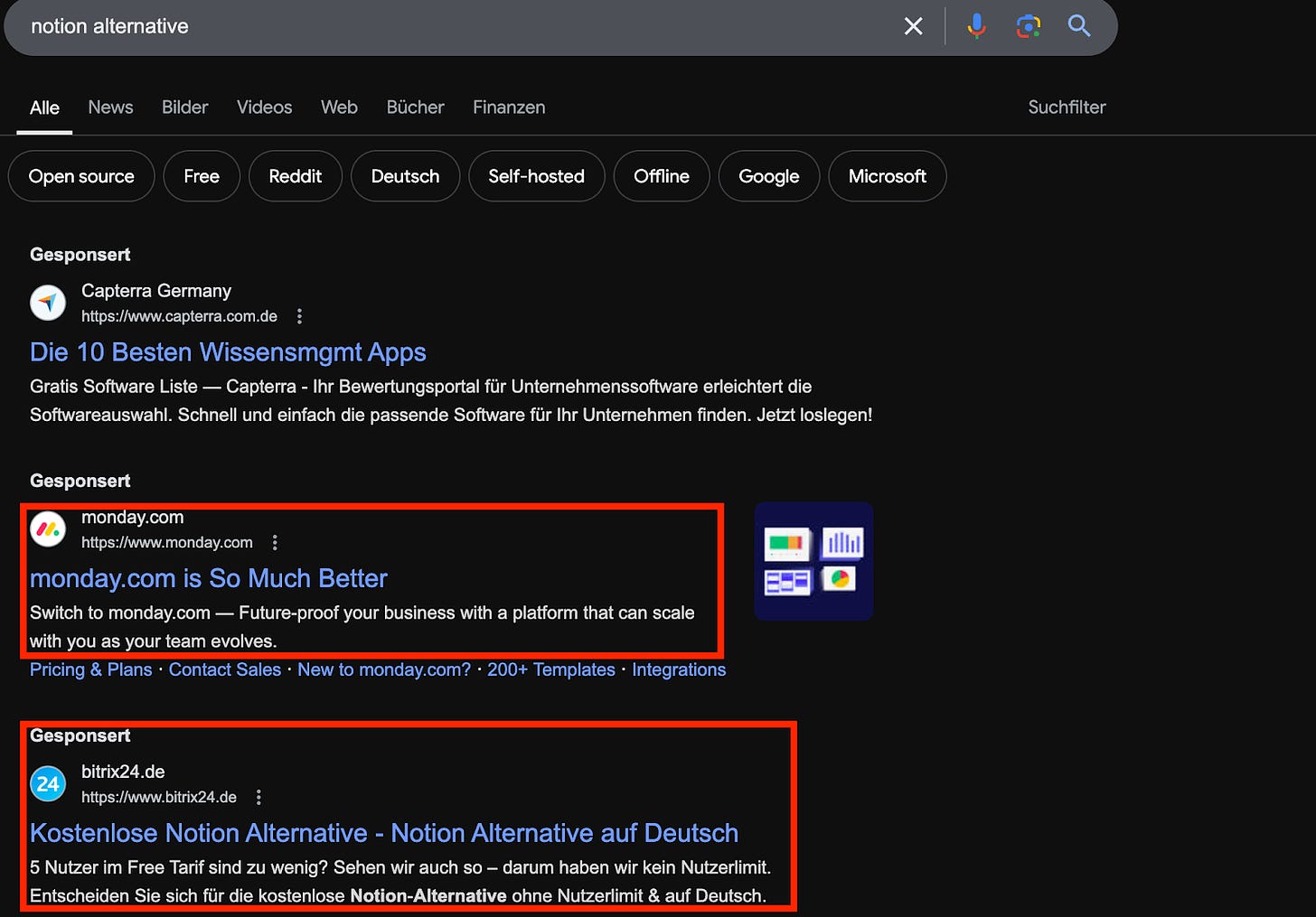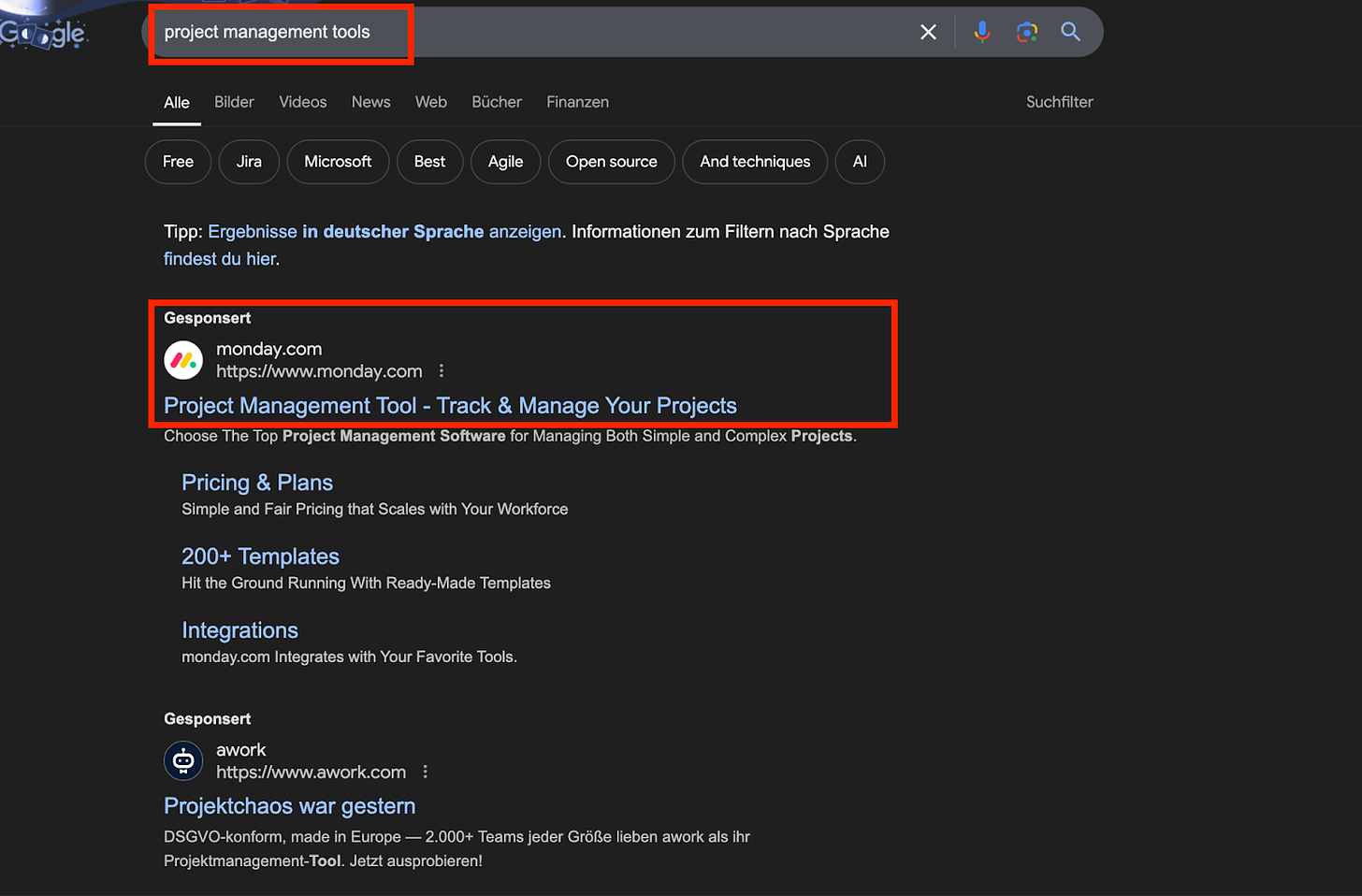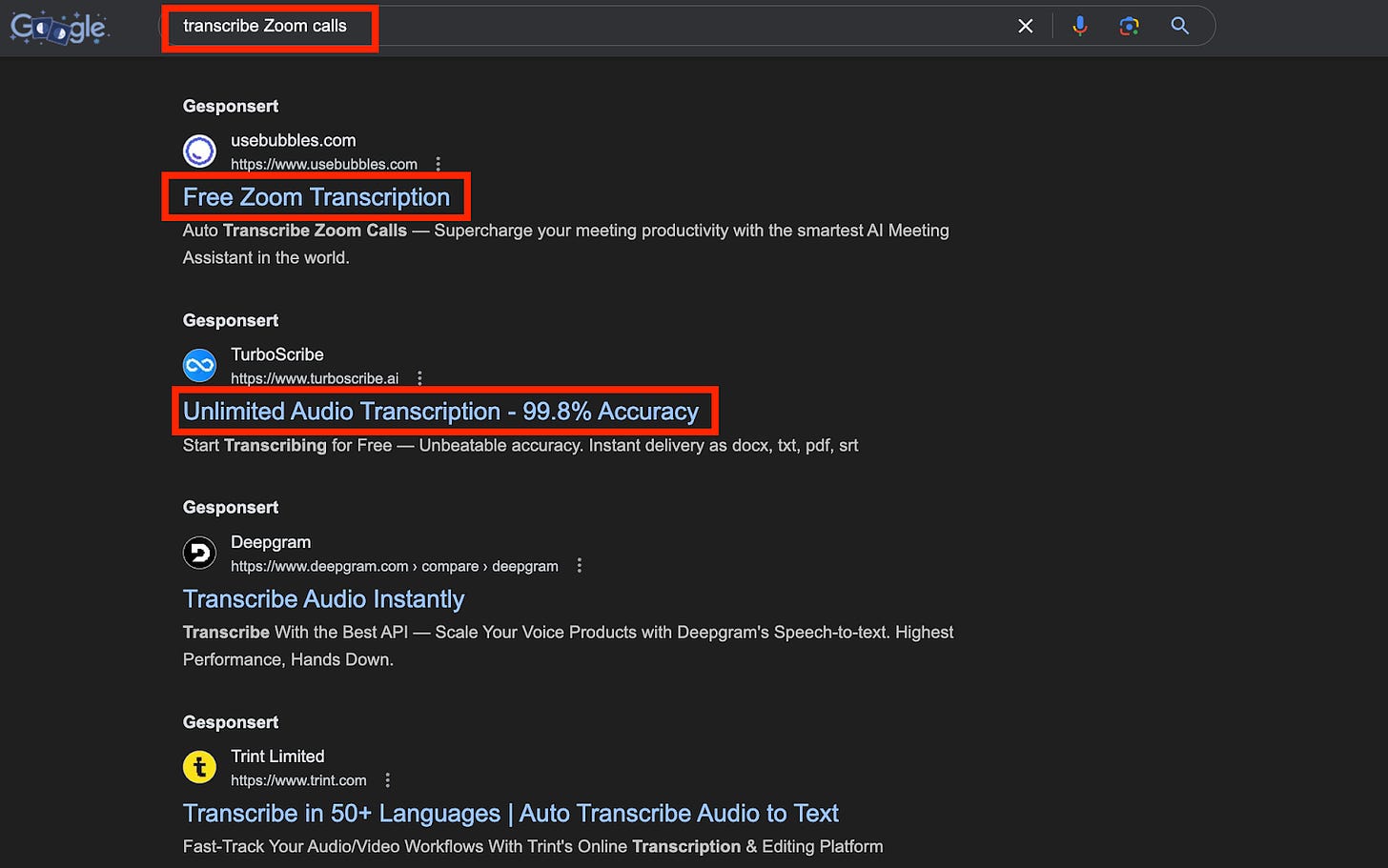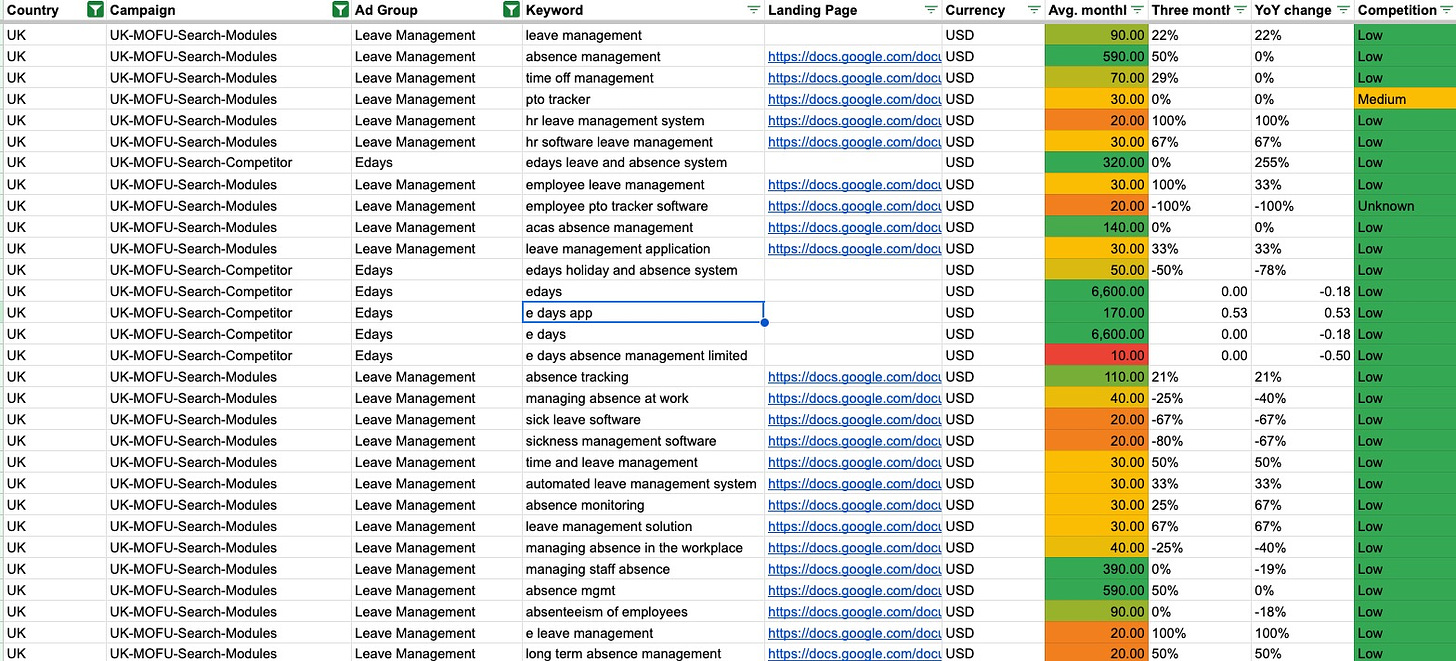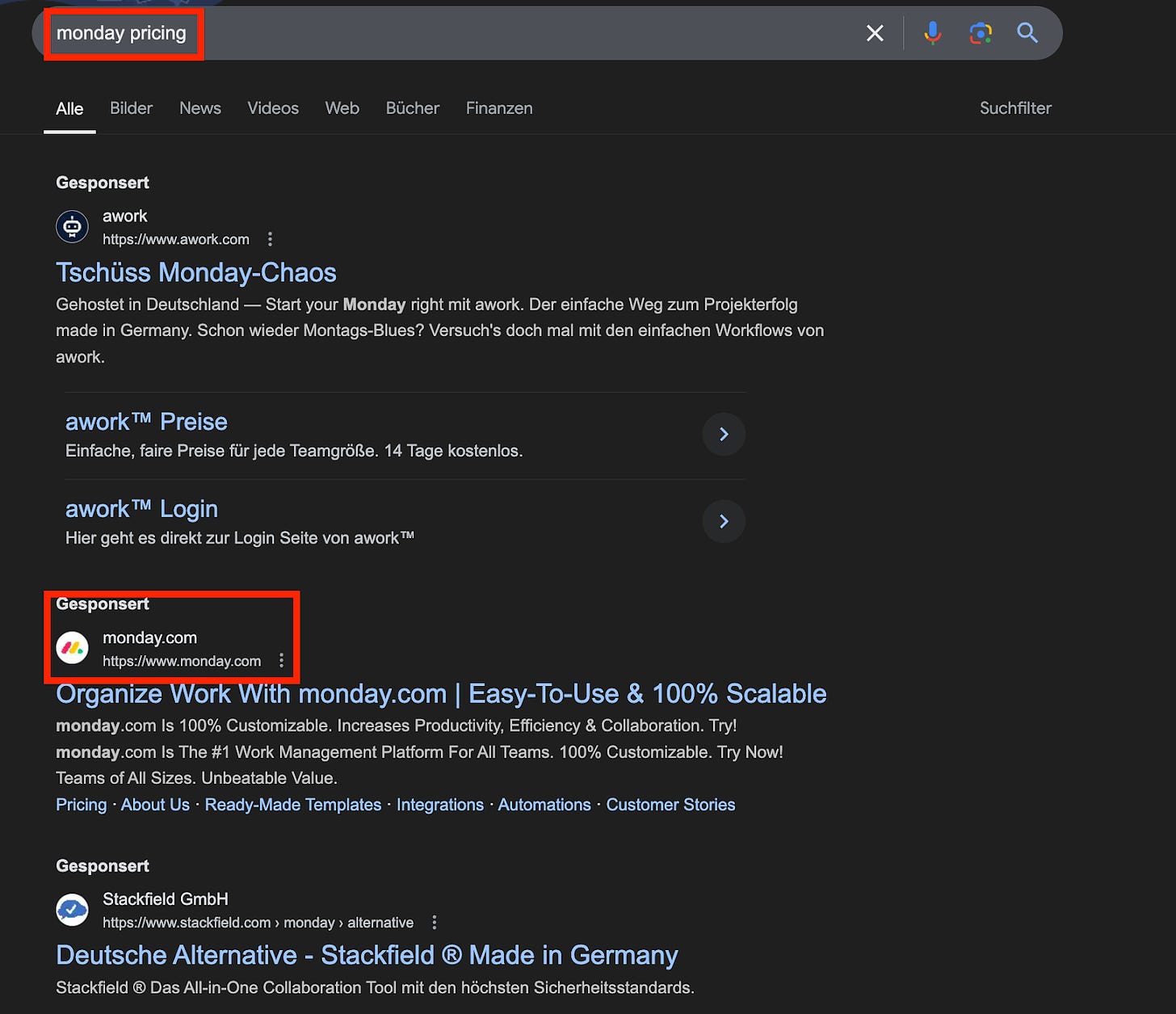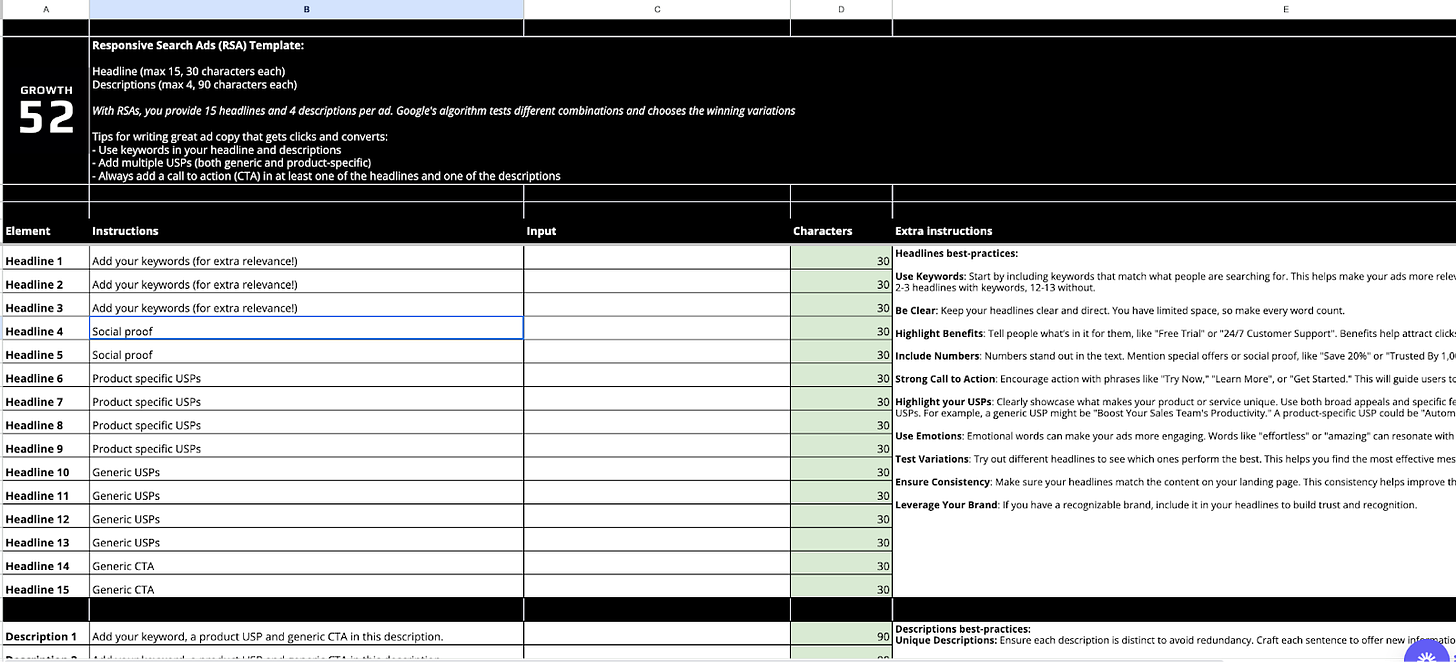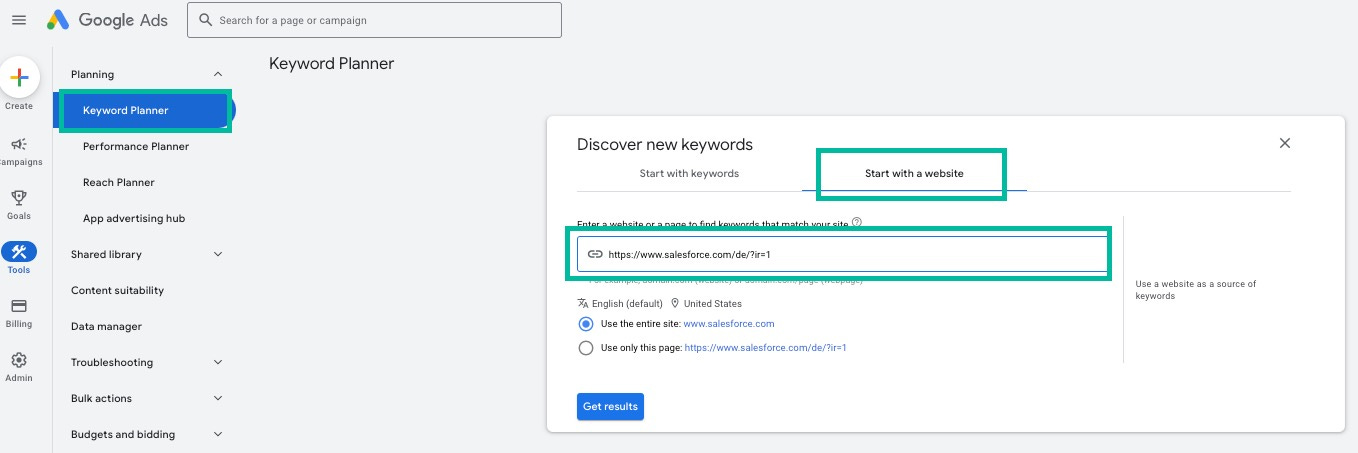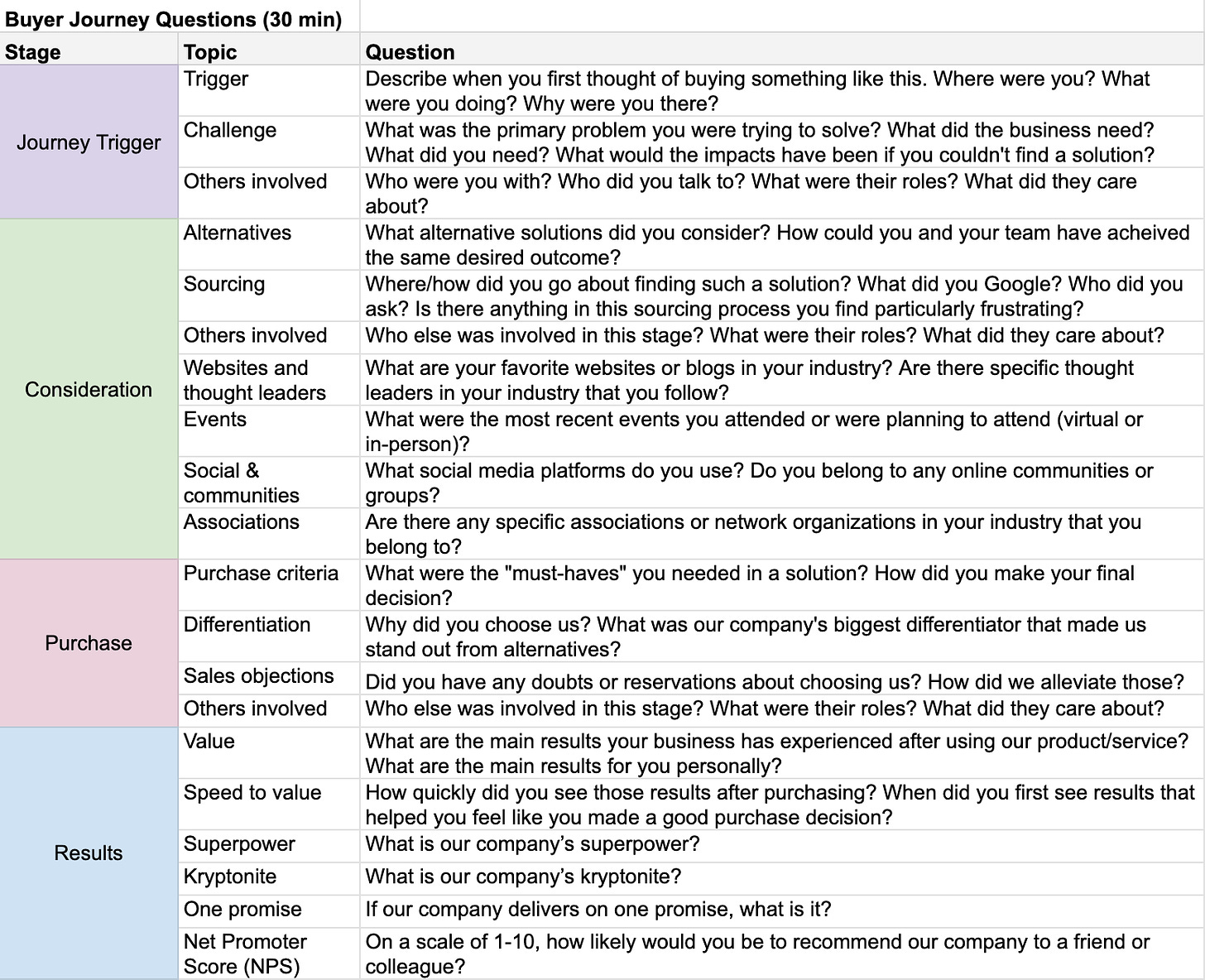Ultimate Guide: How to get started with Google Ads for early-stage B2B SaaS startups
Bonus: Free ad copy template 🔥
Hey - it’s Alex - this time together with Agata (Ex-Googler)!
Today we cover:
1️⃣ When to start with Google Ads
2️⃣ Step-by-Step Guide on how to get started (incl. tracking)
3️⃣ The 4 Best Google Ad Campaigns for SaaS Startups
Bonus:
List of my vetted Go-to software tools for early-stage SaaS startups
In case you missed the last 3 episodes:
✅ From Founder Sales to Founder-led Sales: Your first sales hire
✅ The 9 LinkedIn Social Selling Tactics that work in 2024
✅ The 4-must-have email templates in B2B SaaS Sales
If you’re new to the newsletter: I share with you bi-weekly 3 actionable growth tactics that will help you quickly grow your SaaS business from €0 to €1 million ARR 🚀.
A quick word from our sponsors
📢 Bucket - Easily manage feature access based on subscription
Flip a switch to give customers access to features. Bucket is feature management that’s purpose-built for B2B SaaS.
📢 Oscr AI—the Ultimate Content Creation Engine for founders & marketers
Struggling to keep up with content demands and stay on top of trends?
With Oscr AI, transform research, videos, audio, and long-form articles into engaging, on-brand posts in seconds. From founders to marketers, Oscr AI is the all-in-one toolkit to amplify reach and drive growth.
Want to reach 4000+ early-stage SaaS founders/leaders? Sponsor the next newsletter.
Step-by-Step: Google Ads for early-stage B2B SaaS startups
Every SaaS startup will think about adding a paid channel to their go-to-market strategy sooner or later.
However, launching Google Ads for an early-stage B2B startup is a big deal.
It requires taking a leap of faith and investing money in a channel that might seem like a black box. At the same time, it’s one of the best ways to accelerate customer acquisition, build brand awareness, and give you an edge over competitors.
But here’s the thing: you need to know how (and when) to do it right.
In this guide, we’ll discuss the most critical aspects to consider when starting with Google Ads as an early-stage B2B startup.
For context, this guide is co-authored by Agata who has 15+ years of hands-on paid search experience working with multiple B2B SaaS companies (plus being an Ex-Googler).
Who Should Run Google Ads (And When Not To)
Before diving headfirst into Google Ads, ensure it’s the right fit for your business.
When to Run Google Ads
While we believe Paid search should NOT be among your initial channels, it’s a great channel after initial traction (we will touch on Who & When to use Google ads in more detail later).
Google Ads are great if:
You have a clear understanding of your Ideal Customer Profile (ICP).
You know in which market category you are operating.
Your target audience is searching for solutions like yours online.
You have defined your USPs (Unique Selling Points)
You can spend at least 25-50 Euros daily to test and optimize your campaigns.
Google Ads is a fantastic tool for reaching high-intent users at the exact moment they're looking for a solution. But it's not for everyone.
When NOT to Run Google Ads
Here’s when you might want to hold off:
Your product is so niche that people aren’t searching for it (yet).
Your budget is too small (think less than 20 Euros/day).
You’re not prepared to invest time in conversion tracking setup or regular optimizations.
The bottom line: if your audience is actively searching and you have the budget to test, Google Ads can be a powerful tool for growing your startup.
How to Set Up Your Google Ads Account
Ready to get started? Let’s talk setup.
Setting Up Tracking and Conversion Events
First things first: conversion tracking.
Without it, you’re flying blind.
Conversion data helps Google’s algorithms understand what’s working and what’s not, allowing you to optimize your campaigns for better outcomes, such as qualified leads or sales.
Here’s how to get it right:
Install Google Tag Manager (GTM)
Use GTM to manage all your tracking tags in one place. It's a free tool that makes your life easier.
Setting up your conversion actions using GTM is a more reliable tracking method than importing conversions from Google Analytics (GA4).
For the initial GTM setup, you will need support from your Developer.
Set Up Google Ads Conversion Tracking
By setting up dedicated conversion actions under " Goals " in Google Ads, you can track key actions like form submissions, demo requests, and trial sign-ups.
You can follow this step-by-step video to set it up and add values for your conversion actions.
Defining values for your conversion is important because it helps to more accurately optimize your campaigns towards the actual business impact. Google offers a free calculator that will help you calculate the correct values.
Enable Enhanced Conversion Tracking
Google offers enhanced tracking for more accuracy, even when cookies are blocked.
With enhanced conversions, first-party customer data like an email address or phone number is collected through your conversion tracking tags, encrypted, and sent to Google.
Google then uses this encrypted data to match your customers to their signed-in Google accounts when they interact with your ads. This makes a difference.
Follow this Google Ads tutorial for instructions on how to set up enhanced conversions.
Implement Google Consent Mode
Since March 2024, for companies operating in Europe implementing Google Consent Mode V2 is mandatory. If you don’t implement it Google will block you from collecting any data about EU and UK users in your Google Analytics audience lists. This means you won’t be able to use Remarketing campaigns.
Luckily the implementation is not that complex.
If you are a European startup, you probably already have a consent banner on your website. Chances are that the consent management platform (CPM) behind your banner has a dedicated partnership with Google (you can find a full list of Google’s CPM partners at the bottom of this article). This makes the implementation fairly straightforward.
For example, here is the step-by-step tutorial on how you can implement it in GTM with CookieBot.
Track Offline Conversions
You should set up offline conversions if your leads typically convert offline (like sales calls) or if you want to track more meaningful conversion actions (like MQLs or SQLs).
This is where tools like HubSpot or Zapier come in handy.
If you use HubSpot, as your CRM tool, you can easily connect it to your Google Ads account. Once both are connected, you will be able to track the impact of your campaigns on the business results in Hubspot, as well as set up Offline Conversions. Just follow these instructions.
Real-World Example of How Bad vs. Good Conversion Tracking Can Make a Difference
The biggest issue for many early-stage SaaS startups is poor conversion tracking.
Example: They optimize their ads based on form submissions, which were tracked using conversion imports from GA4. While that’s okay, it is not the best method and was not the best goal to focus on.
Better: Implement offline conversion tracking using HubSpot, which allows you to track more critical goals like MQLs, Sales Opportunities, and Customers.
Structuring Your Account
A well-structured Google Ads account is key to driving performance and making managing your campaigns easier. Here’s how to do it:
Campaigns
Start with a max of two campaigns that target different segments. For example, one campaign could target competitor keywords, and another could focus on product category keywords. Don’t create too many campaigns. When you don’t have enough data in your Google Ads account, too much traffic segmentation into different campaigns will make it harder for Smart Bidding to work correctly. This can lead to higher costs and reduced effectiveness.
Ad Groups
Each campaign should have separate ad groups focusing on specific keywords or themes (e.g., "sales pipeline automation" or "lead nurturing software").
Create one ad group per creative theme: keywords, ad copy, and the landing page of a particular ad group.
Again, don’t overdo it by creating too many ad groups.
A good hack is to structure your campaigns and ad groups according to your website.
Let’s take the example of Miro.
Under their website navigation, you will find “Use Cases”.
Miro could have one Google Ads campaign called MOFU-Search-UseCases, and under this campaign, the following Ad Groups:
Diagramming, Roadmapping, Agile Practices, Product Planning, Prototyping, Cloud Visualization, Customer Journey Mapping:
Ads
With Responsive Search Ads (RSA) you don’t need to create multiple ad variations. RSAs allow you to add 15 headlines and 4 descriptions per ad variation.
For example, imagine you're an HR platform wanting to advertise your SaaS.
With responsive search ads, you can input various headlines like "Easy Leave Management," "Top HR Solution 2024," or "Start Your 14-Day Trial".
Similarly, you can add multiple descriptions, including special offers, CTAs, or unique selling points.
Google Ads then tests all the headline and description combinations, showing your potential customers the most relevant messages based on their search queries. I suggest starting with one ad variation per ad group to give Google the chance to identify the winning combinations quickly. It’s good to remember that 15 unpinned RSA headlines (this is how many you can add per one ad variation) result in 210 two-headline combinations and 2730 three-headline combinations.
For Google to evaluate the performance, it needs around 100 impressions for each combination, which means 300k impressions. That’s why you shouldn’t overdo it by creating too many ad creatives when you start.
Budget Allocation
Let’s use a B2B SaaS startup in the sales automation industry as an example. They have a monthly Google Ads budget of 9,000 Euros. Here’s how we would allocate it:
4,900 Euros for high-intent product category and use case search keywords.
1,800 Euros for competitor keywords.
2,300 Euros for remarketing and brand campaigns.
Why did we split it like that?
For a brand operating in a competitive market (where competitors can bid on your brand keywords), we suggest allocating 20-25% of the budget to the brand campaign. If your brand is not known and nobody is bidding on it, this percentage can be lower (e.g., 10%), and you can spend more on remarketing campaigns. The high-intent product category campaign will probably be your highest converting campaign, so we suggest allocating 60-70% of the budget there. Last but not least is the competitor campaign, where we suggest allocating 20-30% of the monthly budget (competitor keywords might be expensive, so allocating more budget might increase your cost per acquisition).
Recommended Budget
If you’re just starting, spending 25-50 Euros daily is a good rule of thumb.
For competitive market categories like CRM, human resources, or project management software, you may need to allocate 50-500 Euros per day to obtain meaningful data and see results.
To see how competitive your keywords are and estimate the needed budget, you could use the Keyword Planner (you will find it inside Google Ads). This tool will give you insights into the average bid you should expect for your keywords.
In the screenshot below, we see that “HR software” has a significantly higher top-of-page bid than, for example, “CRM Software.”
What Campaigns to Start With
Your Google Ads account is set up, and you know how much you want to spend.
Now, what campaigns should you launch first?
Best Campaigns for B2B SaaS
Start with Search campaigns targeting high-intent keywords. These are the keywords that show strong intent to convert.
Best Campaign 1: Competitor Keywords
Bid on search terms related to your competitors. For example, you could target terms like "Gong alternatives" or "Salesforce competitors."
A good start is to build a comprehensive list of all your competitors and do Google research on how their ads perform. You could then use the Ad Transparency Center to get insight into their ads and ad copies.
The next step is doing keyword research using Keyword Planner. Use the “[competitor name] alternative” or “[competitor name] competitors” to identify the search volume they get.
Mistakes to avoid
When running competitor campaigns it’s crucial not to make these two mistakes:
Mistake 1: Bidding for navigational or informational keywords like “login,” “dashboard,” or “billing”. Make sure you exclude those using negative keyword lists.
Mistake 2: Using a competitor's name inside of your ad copy (RSA headlines) without first checking if a trademark doesn’t protect this brand. Overall, you don’t want to start a fight with your competitors, so it’s always better to create neutral ad copies without using the competitor's brand in them.
Best Campaign 2: Product Category Keywords
Target keywords that relate to your product category. For instance, “sales automation software” or “AI tools for research.”
Once you know who your competitors are, you can check which category keywords they are using in their ads and which category they are listed in on Capterra or G2.
Best Campaign 3: Use Case Keywords
Go even more granular by targeting specific use cases. For example, “transcribe Zoom calls,” “automate lead nurturing,” or “payroll management.”
We recommend starting with keyword research and looking for the keywords across all three categories:
Competitor
product category,
and use case.
Then organize them inside a Google Sheet and map them to potential campaigns and ad groups. See an example of Agata's keyword research for a HR Software:
Best Campaign 4: Brand Keywords
Here’s something you don’t want to overlook: brand keywords.
If your brand is operating in a competitive market, sooner or later, your competitors will likely start bidding on your branded keywords.
For example, they might target terms like "[Your brand] alternatives" or "[Your brand] pricing." Running a brand campaign is crucial to avoid losing potential customers to your competition. This ensures your business shows up first when someone searches for your brand name.
Brand campaigns are also essential for startups that haven’t established strong SEO. If your homepage doesn’t consistently appear at the top of Google’s search results, running a brand campaign ensures that users searching for your brand can find you quickly and easily.
Also, some brand names have multiple meanings. Take "Gong," for example. It’s not just a sales automation company—it’s also a musical instrument. In cases like this, relying solely on organic traffic might not get your audience to the right place. Running a brand campaign helps eliminate confusion and directs users to your website instead of unrelated results.
Templates for Ad Copy (responsive search ads)
To make it easier for you to create high-performing ad copy, use the template below 👇
All you need to do is add up to 15 headlines and up to 4 descriptions.
Google will use these inputs, run various combinations, and come up with the combination(s) that show the best results.
In case you prefer more control and write your own copy, the templates below are a great start point.
Ad copy templates (for the 4 Best SaaS Ads campaigns)
Competitor Keyword Google Ad (Template)
Example: Online Meeting Recording Software
Template 1 (only if you can use the trademark)
Headline: Ditch [Competitor]! 10,000+ Teams Use [Brand]
Description: Frustrated by [Competitor]? Join over 10k teams that switched to [Brand]. Try for Free.
Template 2
Headline: #1 Alternative is [Brand] – 5-Star Rated Zoom Recording
Description: Over 95% of Users Choose Us For Recording & Transcribing Zoom Calls. Explore Why.
Template 3 (only if you can use the trademark)
Headline: Top-Rated [Competitor] Alternative
Description: Rated 4.9 on Capterra for Ease of Use. Explore What Else Customers Love About [Brand]
Product Category Keyword Google Ad (Template)
Example: Online Meeting Recording Software
Template 1
Headline: The #1 Zoom Recording Tool – Trusted by 10,000+ Teams
Description: Looking for the Best Online Meeting Recorder? [Brand] is Trusted by 10k+ teams. Try Free.
Template 2
Headline: 5-Star Zoom Recording Tool – 15,000+ Happy Users
Description: See How [Brand] Transforms Your Zoom Recordings Into Actionable Insights. Try 14-Days Free
Template 3
Headline: Zoom Recording & Transciptions – 10,000+ Users Trust [Brand]
Description: Record, Transcribe, and Analyze Your Zoom Meetings with AI. Try For Free Today.
Usecase Keyword Google Ad (Template)
Example: Online Meeting Recording Software
Template 1
Headline: AI Meeting Transcription?
Description: Discover The Power of Automated Note-Taking with [Brand]. Try For Free.
Template 2
Headline: Transcribe Calls in Real-Time
Description: Instantly Generate a Call Summary and Sync Transcript Into Your CRM. Try For Free
Brand Keyword Google Ad (Template)
Example: Online Meeting Recording Software
Template 1
Headline: [Brand] – 10,000+ Teams Rely on Us for Zoom Call Recordings
Description: Record, transcribe, and summarize Zoom calls effortlessly with [Brand]. Trusted by 10,000+ teams worldwide. Start your free trial today!
Template 2
Headline: [Brand] – 5-Star Rated Zoom Call Recording & Summaries
Description: Professionals love [Brand]! Record, transcribe, and summarize Zoom meetings with ease. Rated 4.9/5 by 12,000+ users. Try it free today!
Template 3
Headline: [Brand]: The #1 Zoom Recording Tool for 10,000+ Users
Description: Join 10,000+ happy users! [Brand] provides seamless Zoom call recordings, AI transcripts, and summaries. Start your free trial now!
Remarketing
Once your search campaigns are humming, you can use a Display campaign to branch out to a Remarketing campaign.
The remarketing campaign re-engages visitors who have already interacted with your website. It’s a great way to remind potential customers about your offering and bring them back into your funnel.
To run remarketing, connect your Google Ads account to Google Analytics 4 and enable Consent Mode (mentioned before).
Once that’s done, you can build audience lists, such as a list of people who have visited your website in the past 30 days and haven’t converted. You can then target this specific list with your image ads, which they will see across the display network and Gmail.
Target this audience with ads leading to competitor comparison pages or case studies. This will help them understand the value of your solution and will give them a final push to convert.
How to Find Relevant Keywords for Your Campaigns
Finding the right keywords can make or break your campaigns.
Keyword Research
Start with Google Ads Keyword Planner.
It’s a free tool inside Google Ads that helps you find high-volume, high-intent keywords relevant to your business.
For example, you could feed the tool with your competitor’s website URL to get ideas for new keywords.
Next, look at what your competitors are doing.
Use tools like Ahrefs or SEMrush to see which keywords they’re bidding on. If it’s working for them, it might work for you.
Finally, get some customer insights.
Talk to your sales and customer service teams. Listen to call recordings.
What common pain points do they hear? What search terms are prospects using?
These can be a goldmine for keyword ideas.
Using Negative Keywords
Don’t forget about negative keywords.
These are keywords you want to exclude from your campaigns.
Why? They prevent you from wasting your budget on irrelevant clicks. For example, if selling a premium SaaS product, you might want to exclude keywords like “free email marketing tool.”
Key Metrics to Monitor Your Campaigns
Once your campaigns run, you’ll want to monitor the numbers closely. Here’s what to track.
Key Performance Metrics
Click-Through Rate (CTR): It measures how many people click on your ads. Aim for a CTR of 3-5%.
Conversion Rate (CVR): This tells you how many clicks lead to conversions. For B2B SaaS, you’ll want a conversion rate of around 1.5% or higher for demo sign-ups or MQLs. For free trial signups, you should aim for at least 7%.
Cost-Per-Acquisition (CPA): How much are you paying to acquire a customer? Based on your conversion goal, use the conversion rates (e.g. MQL-to-Customer CVR) to calculate the max you are willing to pay for a conversion. You will need it for setting up target CPAs across your campaigns using the Maximize Conversions as a bidding strategy. So you will end up having a maximum you’re willing to pay (e.g. cost per lead, cost per MQL/demo/trial, etc.)
Example for Our Sales Automation Startup
In our case, we aim for:
CTR: 4% for competitor keywords.
Conversion rate: 1% for product category keywords and 1.5% and higher for brand keywords
CPA: 120 Euros for high-intent keywords, which we set up as a target CPA inside of campaigns.
Tools to Enhance Tracking and Reporting (advanced)
Looker Studio Templates: Use one of these templates to visualize your campaign performance in real time. You can track metrics like CTR and CPA at a glance.
Collection of free Google Ads templates created by the Looker Studio team
Google Ads for Lead Gen dashboard by Niklas Buschner (you need to become a paid member of his community to access it)
Google Ads Scripts: Automate reporting and gain additional insights into your campaigns. Scripts can help you identify underperforming keywords or alert you to sudden changes in performance. Some of the recommended scripts:
Trending Search Terms - monitor how Google is matching new search terms to your keywords and what is changing in the search behavior of your audience.
RSA Quality Overview - get an overview of all Responsive Search Ads in your account with their associated rating.
Quality Score Tracker - you can see how your quality score performs over time.
Link Checker - it alerts you when a landing page on your website is not working, helping you prevent unwanted ad spend (e.g. 404 error).
Closing Thoughts
Google Ads can be a game-changer for early-stage B2B startups—if you use it right.
Focusing on high-intent keywords, properly tracking conversion, and effectively structuring your campaigns can drive real business results.
If you’re interested in Google Ads, then these 4 guides might be relevant to you too:
Bonus Material: Library of 100+ Ads of SaaS companies
Special Offer 🎉
If you believe Google Ads is what you need now to grow your B2B SaaS, we have a special offer for you.
Option 1: Audit for 360€ (instead of 1800€)
What’s included in the package?
Audit of your Google Ads account & campaigns with practical recommendations
Option 2: Optimization Package for 3500€ (instead of 4000€)
What’s included in the package?
Audit of your Google Ads Account & campaigns with practical recommendations
Set-Up/Revamp of your Google Ads Account (incl. Conversion Actions & Tracking)
Launch of up to 3 campaigns (competitors, product category, use case brand)
Sign up here for our special Google Ads offer.
Bonus material
Understand your customers with 20 ready-to-use buyer interview questions
Happy growth 🚀
3 ways I can help you grow your SaaS to €1 million ARR 🚀
Build your GTM strategy with my free SaaS GTM Strategy Workbook (helped 4000+ SaaS leaders)
Get access to 100+ actionable SaaS growth tactics (helped 250+ SaaS leaders) - 100% positive ROI guarantee.
Work 1-on-1 with me - GTM Advisory for early-stage SaaS founders on their way to €1 million ARR (1 free spot - limited to 8 founders).


